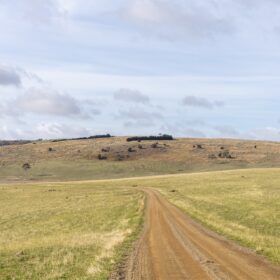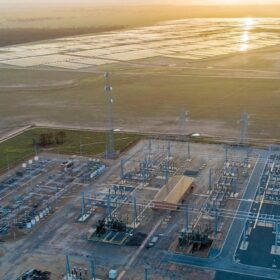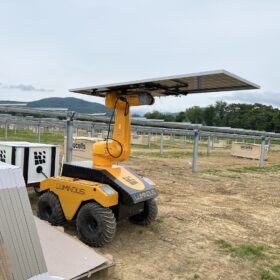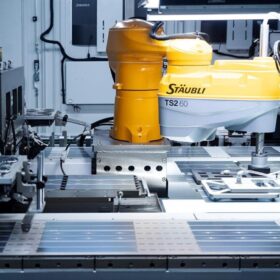Top News
Horizon seeks federal approval for Derby solar and storage plans

Malaysian giant teams with Tasmanian landowners on 1.2 GW portfolio

Atmos reaches financial close on 400 MWh battery project
Out now - pv magazine Global June edition

Robotics company lands federal funds to scale up solar construction

Tongwei achieves 91.7% bifaciality factor for 722 W TOPCon solar module
Report reveals renewable energy potential of Aboriginal land holdings in NSW
Brisbane battery manufacturer makes moves into US market
NSW green bank backs energy projects with $1 billion purse
Press Releases
Clean Energy Council approves GoodWe’s EHB single-phase hybrid inverter
JinkoSolar’s Eagle G6R residential PV module honoured in annual awards
Queensland’s TAFE Centres of Excellence lead Australia with competitive grants program
JA Solar wins RETC “Overall Highest Achiever” award for sixth consecutive year
Opinion & Analysis
Featured
What does Australia’s new battery rebate mean for V2G technology?
The solar battery rebate scheme must not become ‘Pink Batts 2.0’
The Albanese Government’s $2.3 billion solar battery rebate scheme is one of the most exciting developments Australia’s energy sector has seen in years but if we don’t get the rollout right from day one, we risk undermining everything this scheme stands for and repeating the disastrous mistakes of the Pink Batts program.
The KPIs that quietly drive battery market share in Australia
The Australian residential battery market is heating up — and beneath the surface, a new set of performance metrics is emerging as decisive for brand success. While some manufacturers chase short-term growth by dropping prices, the real battle for sustainable market share is being fought on deeper metrics: share of installer adoption, share of installer portfolio, and customer loyalty.
Bringing back-contact to the foreground
Solar manufacturers are pursuing the next-generation crystalline silicon (c-Si) PV cell technology. Back-contact (xBC) technologies including TOPCon back-contact (TBC), HJT back-contact (HBC), and HJT TOPCon back-contact (HTBC) have emerged as leading candidates, attracting attention for their superior conversion efficiency and aesthetic module designs.
How grant system is locking millions away from those doing heavy lifting
Australia’s grant system is working exactly as designed. And that’s the problem. Right now, if you’re a small business or a not-for-profit, there’s likely a funding stream available to help you test an idea, buy equipment or build capability. If you’re a multinational or a university, there’s even more. But if you sit in the middle, a commercially viable, medium-sized business with proven success, and the capacity to deliver major outcomes, you’re often left with nothing. This isn’t sour grapes, it’s missed opportunities.
Why a big battery is cheaper than small with federal battery rebate
The federal government has announced a national battery rebate scheme that comes into effect on July 1, although many eligible installations have already taken place.
Markets & Policy
Featured
Stanwell exits Gladstone green hydrogen project
Trinasolar targeting ‘high-value’ markets
Yang Bao, Trinasolar’s president of global sales and marketing, recently spoke with pv magazine about the company’s strategy for the solar and energy storage business.
Alinta gives construction go-ahead for 250 MW battery project in South Australia
Alinta Energy has locked in construction of the first 250 MW / 1,000 MWh stage of a 500 MW, four-hour battery energy storage system planned for South Australia and appointed local construction firm GenusPlus Group as principal contractor.
Ace Power’s 8 GWh battery project clears federal hurdle
A battery energy storage system of up to 1 GW and 8 GWh capacity has been given the green light for northern New South Wales after securing environmental approval from the federal government.
Sinovoltaics tracks 86.5 GW of module output capacity for Southeast Asia
PV module manufacturing capacity in Southeast Asia has reached 86.5 GW across 61 active sites, according to Hong Kong-based quality assurance firm Sinovoltaics. The figures come from the company’s latest “Southeast Asia Solar Supply Chain Map” report.
30 MW of home-grown Tindo solar panels to power major water project
Adelaide-based solar panel maker Tindo will supply 30 MW of its Australian-made solar panels to power Queenland’s large-scale, 182 kilometre underground Bowen Water Pipeline project.
Installations
Featured
How albedo interacts with rooftop PV system patterns
Project to test floating PV on farm dams to save water, generate electricity
The feasibility of deploying floating solar systems on farm-based water storages to optimise water retention and generate renewable energy that could serve as an alternative income stream for landholders will be investigated as part of an Australian-first research project.
New South Wales councils not waiting for government to mandate electrification
With just 54 months until New South Wales reaches its 2030 50% emissions reduction target, five councils are taking matters into their own hands to mandate the electrification of all new buildings, except industrial.
The best tilt angle to improve PV system performance on low-income housing
Researchers have demonstrated that the theoretical optimal tilt for rooftop solar energy production in low-cost buildings in Nigeria is approximately 5.67°. Their modeling suggests to adopt south-facing roofs for PV generation in the southern hemisphere.
Discounts don’t buy home battery trust in rebate landscape: study
A new study out of Curtin University in Perth has found that despite growing affordability from government rebates, Australian households hesitate to adopt home batteries due to significant non-financial barriers.
Future NEM reliability forecast to flounder without investment increase
AEMO forecasts potential reliability gaps as early as 2026-27 in South Australia and 2027-28 in New South Wales, based on current committed and anticipated projects, but new investment would narrow the risks.
Technology
Featured
MoorPower takes next step on commercialisation journey
Australian battery maker targets military-related applications
Queensland battery technology developer Li-S Energy has signed a supply and testing agreement with an unnamed defence technology company, targeting integration of lithium-sulfur battery solutions into advanced military and security systems.
SERIS achieves world record efficiency of 26.7% for perovskite-organic tandem solar cell
The tandem device is based on a bottom organic cell that can achieve a power conversion efficiency of 17.9% and a high short-circuit current density of 28.60 mA cm2. Furthermore, it uses a top perovskite solar cell with an open-circuit voltage of 1.37 V and a fill factor of 85.5%.
Policy shifts needed to unlock existing transmission network capacity
Neara co-founder Jack Curtis says the opportunity to boost capacity of existing transmission networks is possible with smarter grid solutions and derisk reliance on new transmission projects facing potential delays.
Neighbourly nod to transmission line impact sets social licence precedent
Victorian network company AusNet has launched a new program that entitles landowners of properties neighbouring the proposed Western Renewable Link transmission project to one-off payments of $20,000 or $40,000.
JinkoSolar achieves world record efficiency of 27.02% for TOPCon solar cell
The Chinese manufacturer said the result was certified by China’s National Photovoltaic Industry Measurement and Testing Center (NPVM).
Manufacturing
Featured
Australian cell manufacturer launches first module series
Longi, Pertamina begin work on 1.4 GW solar cell, module factory in Indonesia
Chinese solar manufacturer Longi and Indonesian state-owned energy company Pertamina have started construction on a 1.4 GW solar cell and module production facility in West Java, Indonesia.
1.5 million solar panels sought in project procurement package
Procurement and works packages for what is set to be one of the largest solar farms connected to Australia’s main electricity grid are now live with developer Genex Power seeking expressions of interest from trade contractors and suppliers for the Bulli Creek Solar project.
WA Budget measures designed to bolster local battery manufacturing
The Western Australian government has committed $50 million to scale up the local battery manufacturing industry to take advantage of an expected surge in demand for household energy storage systems.
Fox ESS unveils hybrid high-power inverter for C&I applications
Fox ESS has launched a hybrid high-power inverter for commercial and industrial use, with parallel operation of up to 10 units enabling 1.25 MW output and 7.2 MWh storage. The Chinese manufacturer says the system offers 97.6% European efficiency and 98.2% peak efficiency.
Indonesia, Singapore partner on solar supply chain in Riau Islands
Indonesia and Singapore have signed a memorandum of understanding to develop a solar manufacturing supply chain in Indonesia’s Riau Islands province, as part of broader plans to enable cross-border clean energy trading.
Energy Storage
Featured
Western Australia warns solar traders against bogus battery rebate activity
Smart data unlocks solutions for network challenges
As Australia’s distribution network service providers grapple with challenges sparked by the rise of distributed energy resources, EA Technology says leveraging insights from grid-edge intelligence can unleash the full potential of their networks.
Eku Energy enters NZ with 300 MW battery project purchase
Eku Energy has bought a major battery energy storage project in New Zealand’s North Island to build out its storage assets.
GoodWe releases 112 kWh storage system for C&I solar
GoodWe has launched a 112 kWh battery energy storage system for commercial and industrial solar projects, featuring 96% round-trip efficiency and a 6,000-cycle lifespan. The system allows parallel connection for up to 450 kWh of total capacity.
Researchers report zinc-ion battery life breakthrough
Australian researchers are reporting a breakthrough with zinc-ion battery technology, developing a new method to significantly boost the structural stability of the cathode material that enables the battery to operate reliably for more than 5,000 charge-discharge cycles.
Potentia issues notice to proceed for 130 MW battery in NSW
Potentia Energy has given the go-ahead for a 130 MW battery energy storage project in New South Wales, saying the deployment of its grid-forming inverter technology will play a critical role in Australia’s renewable energy transition.


